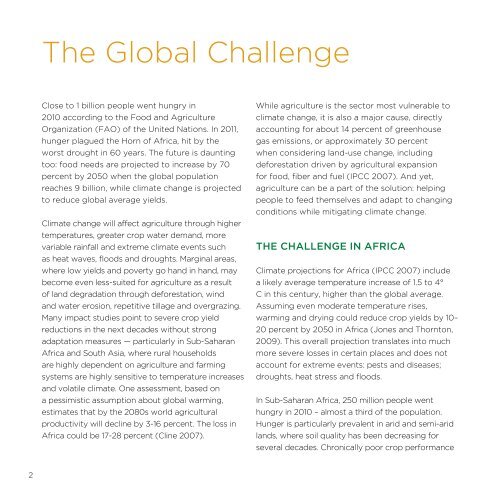Climate Smart Agriculture: A Call to Action - PROFOR
Climate Smart Agriculture: A Call to Action - PROFOR
Climate Smart Agriculture: A Call to Action - PROFOR
Create successful ePaper yourself
Turn your PDF publications into a flip-book with our unique Google optimized e-Paper software.
The Global Challenge<br />
Close <strong>to</strong> 1 billion people went hungry in<br />
2010 according <strong>to</strong> the Food and <strong>Agriculture</strong><br />
Organization (FAO) of the United Nations. In 2011,<br />
hunger plagued the Horn of Africa, hit by the<br />
worst drought in 60 years. The future is daunting<br />
<strong>to</strong>o: food needs are projected <strong>to</strong> increase by 70<br />
percent by 2050 when the global population<br />
reaches 9 billion, while climate change is projected<br />
<strong>to</strong> reduce global average yields.<br />
<strong>Climate</strong> change will affect agriculture through higher<br />
temperatures, greater crop water demand, more<br />
variable rainfall and extreme climate events such<br />
as heat waves, floods and droughts. Marginal areas,<br />
where low yields and poverty go hand in hand, may<br />
become even less-suited for agriculture as a result<br />
of land degradation through deforestation, wind<br />
and water erosion, repetitive tillage and overgrazing.<br />
Many impact studies point <strong>to</strong> severe crop yield<br />
reductions in the next decades without strong<br />
adaptation measures — particularly in Sub-Saharan<br />
Africa and South Asia, where rural households<br />
are highly dependent on agriculture and farming<br />
systems are highly sensitive <strong>to</strong> temperature increases<br />
and volatile climate. One assessment, based on<br />
a pessimistic assumption about global warming,<br />
estimates that by the 2080s world agricultural<br />
productivity will decline by 3-16 percent. The loss in<br />
Africa could be 17-28 percent (Cline 2007).<br />
While agriculture is the sec<strong>to</strong>r most vulnerable <strong>to</strong><br />
climate change, it is also a major cause, directly<br />
accounting for about 14 percent of greenhouse<br />
gas emissions, or approximately 30 percent<br />
when considering land-use change, including<br />
deforestation driven by agricultural expansion<br />
for food, fiber and fuel (IPCC 2007). And yet,<br />
agriculture can be a part of the solution: helping<br />
people <strong>to</strong> feed themselves and adapt <strong>to</strong> changing<br />
conditions while mitigating climate change.<br />
The Challenge in Africa<br />
<strong>Climate</strong> projections for Africa (IPCC 2007) include<br />
a likely average temperature increase of 1.5 <strong>to</strong> 4°<br />
C in this century, higher than the global average.<br />
Assuming even moderate temperature rises,<br />
warming and drying could reduce crop yields by 10–<br />
20 percent by 2050 in Africa (Jones and Thorn<strong>to</strong>n,<br />
2009). This overall projection translates in<strong>to</strong> much<br />
more severe losses in certain places and does not<br />
account for extreme events: pests and diseases;<br />
droughts, heat stress and floods.<br />
In Sub-Saharan Africa, 250 million people went<br />
hungry in 2010 – almost a third of the population.<br />
Hunger is particularly prevalent in arid and semi-arid<br />
lands, where soil quality has been decreasing for<br />
several decades. Chronically poor crop performance<br />
2

















